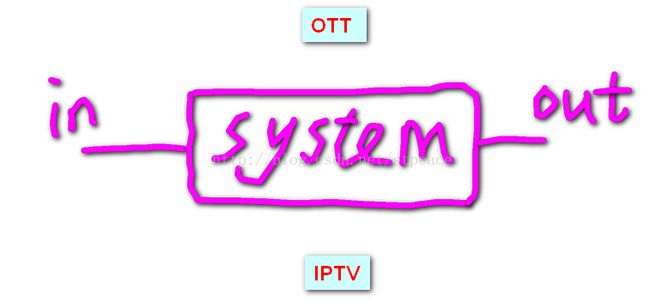iptv与ott (转自维基百科)
英语就是准确啊!红色部分是我自己的理解。
OTT (Over the Top Technology) and IPTV (Internet Protocol Television) are two growing technology mediums(实际上就是两种机制) in the media(这个媒体指代媒体内容) distribution industry that are in place in the market(存在于市场中), yet not being used to their full capacity by advertisers or the critical mass.
Both are systems(两种系统, 机制) through which television services(内容) are delivered using the Internet(都利用因特网), instead of the traditional terrestrial(传统落后的天线), satellite signal(传统落后的卫星信号) and cable television(传统落后的有线电视) formats. However there are several differences between the two, mainly that IPTV is delivered over a service provider’s own infrastructure(IPTV基于运营商自己的设施进行分发内容), while OTT comes over the public Internet(OTT基于公用的因特网进行分发内容).
Over-the-top content (OTT) describes broadband delivery of video and audio without(在传输内容时候,OTT没有复杂的系统控制) a multiple system operator being involved in the control or distribution of the content itself. The provider may be aware of the contents of the IPpackets but is not responsible for, nor able to control, the viewing abilities, copyrights, and/or other redistribution of the content(你我他, 路人甲均可以作为内容提供者). This is in contrast to purchase or rental of video or audio content from an Internet provider, such aspay television video on demand or an IPTV video service(这点和IPTV的内容提供方式不同), like AT&T U-Verse. OTT in particular refers to content that arrives from a third party(他人, 别人, 第三方), such as NowTV,Netflix, WhereverTV, Hulu, Emagine or myTV, and is delivered to an end user device(广大用户设备), leaving the ISP responsible only for transporting IP packets(把传输过程交给Internet).
Internet Protocol television IPTV is a system through which televisionservices are delivered using the Internet protocol suite over a packet-switched network such as the Internet(IPTV也利用因特网), instead of being delivered through traditionalterrestrial, satellite signal, and cable television formats(前面解释过, 此处不解释).
IPTV services may be classified into three main groups:
- live television, with or without interactivity related to the current TV show;(直播)
- time-shifted television: catch-up TV (replays a TV show that was broadcast hours or days ago), start-over TV (replays the current TV show from its beginning);(时移)
- video on demand (VOD): browse a catalog of videos, not related to TV programming.(点播)
IPTV is distinguished from Internet television(IPTV和网络电视不同) by its on-going standardization process (e.g., European Telecommunications Standards Institute) and preferential deployment scenarios in subscriber-based telecommunications networks with high-speed access channels into end-user premises via set-top boxes(IPTV要用机顶盒) or other customer-premises equipment(或者其他的CPE。从上面的other可以看出, 机顶盒也是CPE的一种, 事实也正是如此).
The main difference between OTT and IPTV is that though(表明后面的但是才是重点) both use internet, OTT streaming is delivered through open unmanaged internet(无限制的网), while IPTV use a dedicated, managed network(有限制的网). [1]
OTT has been gaining widespread popularity over the past two years with relatively low cost service providers like Netflix, Hulu, myTV and many more, and provides more freedom, convenience and empowerment to users which gives a greater role for content providers to have a direct relationship with viewers(OTT是一个开放系统).
| OTT (Over the Top Technology) | IPTV (Internet Protocol Television) | |
|---|---|---|
| Content Delivery | Uses open internet, unmanaged network "open ecosystem" | Uses dedicated, managed network. "Walled Garden ecosystem" |
| Network Type | Delivered from the provider/content aggregator to the viewer using open network | Closed, proprietary network, accessed via a specific internet service provider |
| Network Ownership | Without the need for intervening carriage negotiations, or infrastructure investments | Services are optimized and customized to suit the network and end-device capability |
| Quality of Service (QOS) | Not guaranteed, works under best effort conditions | Enables control over quality of delivery |
| Examples | Popular Video on demand services like Sky Go,YouTube, Netflix, Amazon, Lovefilm, BBC iPlayer,Hulu, myTV etc. | Service Example includes U-verse (AT&T), PrismTV (Century Link) |
| Protocol | Delivered using HTTP (TCP), a connected transport protocol. Emerging trends using adaptive streaming technologies like HLS (Apple), Smooth Streaming (Microsoft) and HDS (Adobe). Delivered content over UDP in combination with FEC (Octoshape) | Traditional IPTV uses TS (transport stream) transmission technology. Delivers content over UDP in combination with FEC (Octoshape), connectionless protocol |
| Content Catalog | Widely used for freemium and economical VOD delivery models | Used primarily for premium content and real time content delivery like broadcasting TV |
| Content Type | Premium Content | Premium Content |
| Routing Topology | Unicast (Based on HTTP) or Simulated Multicast (UDP/TCP) | Multicast, Unicast burst during channel change leading multicast join |
| Category | Complementary Service | Parallel service catefory to Cable/Satellite |
| Major Players | OVP (Kaltura, Brightcove, Ooyala), CDN Players (Akamai, L3, Limelight, Octoshape) and Content Aggregators | TSP and IPTV Platform vendors - Microsoft Mediaroom (Ericsson), Alu, Cisco |
| Key Challenges | Low quality, Non Premium Content No Live Broadcast, Unicast model | Expensive, Competition from Cable/ DTH industry, Bandwidth and Infrastructure |
| Key Benefits | Low cost, Flexibility of content consumption across devices | Interactive Service, Quality of Service and Quality of Experience |
总而言之, IPTV与OTT的in不同, System不同, out也不同, 看下面的图, 我就不多说了:
